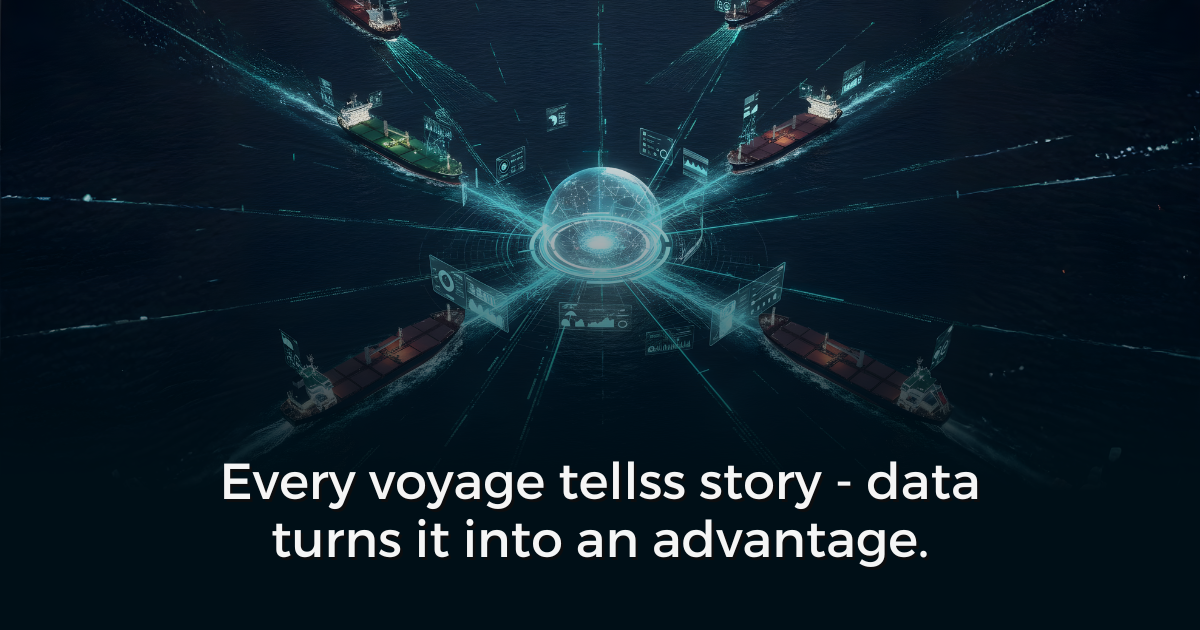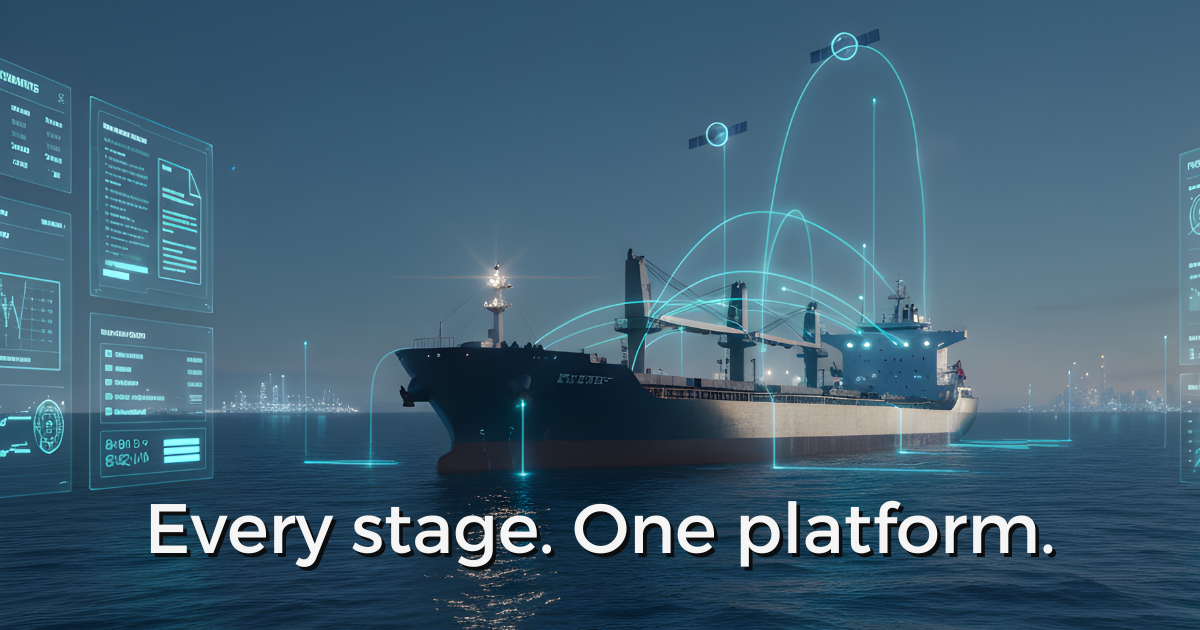Unifying finance and voyage operations: Reducing reconciliation risk
In today’s fast‑moving maritime industry, operators struggle not only with navigating seas, but with navigating silos. Historically, the voyage...
Solutions Aligned with Maritime Roles
Model-Specific Business Solutions
Streamlined data insights
Optimized maritime voyage planning
Enhanced financial stability
Maritime-focused business banking
Access legal documents and policies.
Get solutions to all your questions.

In today’s fast‑moving maritime industry, operators struggle not only with navigating seas, but with navigating silos. Historically, the voyage operations team charts the vessel’s course, logs port calls and fuel burn; the finance team posts invoices, tracks payables/receivables and reports P&L. Too often, these functions live in separate systems. The result? Reconciliation gaps, invoicing delays, disputed costs—and hidden financial risk.
This comprehensive blog post delves deep into how integrating voyage operations and finance workflows reduces reconciliation risk, drives cash‑flow performance, improves audit readiness, and strengthens commercial control. Drawing on recent research from shipping, logistics and broader finance operations, we’ll unpack key drivers, benefits, technology enablers, common pitfalls and a roadmap for implementation.
When operations and finance use different platforms or even spreadsheets, data drift occurs: voyage events logged by operations aren’t automatically posted to finance, invoices may be generated from outdated estimates, and chartering/operations may not see the “real” financial outcome until months later. Research in freight & logistics shows that such disconnects lead to delays in invoice generation, unpredictable cash‑flows and cost leakages. In finance more broadly, manual reconciliation is becoming a critical back‑office risk as transaction volumes and complexity increase:
“Manual match fatigue … leads to days of combing through unmatched transactions.”
In shipping, invoice generation often depends on voyage completion, cost finalisation (fuel, port, bunkers, demurrage) and approvals. If operations and finance are disconnected, invoice cycle times lengthen. According to industry commentary, “delays in billing turn into delays in payment — compounding financial pressure.”
When operations track costs one way and finance posts differently, mismatches arise. These may become disputes with charterers or suppliers, unrecognised supplier credits, or even mis‐posted liabilities. Research in procurement/finance integration shows that lack of visibility and duplicated work raise costs and risk:
“When procurement and finance operations are not integrated … it becomes difficult to track expenditures, forecasting budgets, and identifying cost‑saving opportunities.”
Shipping involves charter parties, multi‑currency transactions, environmental levies, port charges, bunker accounting, and more. From a financial control perspective, when reconciliation is manual or error‑prone, audit trails get broken, and the company may face regulatory exposure. The broader finance field notes that reconciliation errors can lead to incorrect valuations, exposures and regulatory penalties.
When operations and finance are tightly linked—data flows automatically, approvals and postings are aligned, and both teams share a unified record of voyages—multiple kinds of risk diminish. Key benefits include:
Instead of operations, chartering, procurement and finance each maintaining their own versions of a voyage record, integrated systems unify the voyage lifecycle: fixture → execution → cost posting → settlement. That means when a voyage is logged, the financial posting, P&L, cost reports and invoice generation downstream use the same data. This reduces version‑control issues and eliminates many reconciliation tasks.
With operational events feeding finance modules automatically (bunker consumption, port disbursements, voyage amendments), invoice generation can be expedited and aligned with actual execution. Fewer manual marks mean fewer disputes and faster cash‑flow. Industry commentary emphasizes that connection of invoice systems to operational “event data” enables commercial clarity from bridge to balance sheet.
If operation‑costs feed finance automatically, the need for manual matching, re‑keying data and chasing variances is reduced. For finance teams experiencing high volumes, this reduction is material: “Reconciliation is breaking at scale.”
Finance stakeholders gain near‑real‑time visibility into voyage costs, supplier payables, deferred liabilities and receivables. This enables more proactive control of working capital and commercial outcomes. Integration between procurement/operations and finance shows that cost overruns are easier to spot, and that spending aligns more closely with budgets.
Because the data flows from operations into finance and postings are traceable end‑to‑end, audit trails become stronger, regulatory disclosures become easier, and the risk of missing or mismatched transactions drops significantly. In finance integration literature, one benefit is “better compliance” through improved processes and standardised data flows.
To achieve the benefits described above, certain building blocks must be in place. Here are the essential enablers:
Operations teams must feed cost and activity data that align with finance’s coding and ledger structure. Without consistent classification, automatic postings are impossible and mismatches proliferate. Finance‑integration frameworks stress the need for “synchronising procedures” and standardised data flows.
Manual export/import processes are slow and error‑prone. Modern integration uses APIs or event‑driven architecture so operational systems (voyage management, bunker monitoring, port disbursements) post directly into finance/ERP systems. This kind of approach is central in digital transformation frameworks for shipping.
Operations and finance functions must share process definitions and KPIs. For example: when a port call cost is logged, operations commit the cost; finance must recognise it. When charter amendment occurs, both must be aware of the cost impact. Without process alignment, data flows will still fail. In procurement/finance research, this is cited as a key challenge.
Decision makers benefit when voyage cost, revenue, supplier payables and receivables are visible in one dashboard. This transparency enables earlier corrective action and reduces the risk of “surprise” cost overruns or invoicing delays. Integrated finance literature emphasises “greater visibility” as a key outcome.
Integration brings risks too: automatic postings must still follow control frameworks (approvals, segregation of duties, audit logs). Ensuring that operational entries are validated and finance postings have control steps preserves integrity. In reconciliation‑risk studies, poor control is cited as a major failure point.
Below is a structured approach tailored for maritime operators seeking to reduce reconciliation risk by integrating operations and finance.
Map all voyage‑to‑finance workflows: chartering, operations, port disbursements, bunker, invoicing, settlement.
Identify systems in use: voyage management, procurement, port agents, finance/ERP.
Document reconciliation points: where manual matching happens, where variances occur, average days from voyage end to invoice.
Set baseline KPIs: invoice cycle time, number of invoice disputes, DSO, cost variances.
Define unified voyage record: fixture, vessel, voyage leg, cost events, revenue events.
Align cost coding between operations and finance (chart of accounts, cost centres, voyage IDs).
Select integration architecture: APIs, middleware, ETL, event‑driven messaging.
Define control and audit workflows: approvals, exceptions, escalation paths.
Select one trade lane or fleet segment for pilot (e.g., one vessel class, one region).
Integrate operational cost events (port disbursements, bunkers) into finance system automatically.
Generate live dashboards showing voyage cost posting and variances.
Measure pilot KPIs against baseline.
Automate invoice creation by linking actual voyage cost/revenue data.
Enable finance review and approval within workflow before sending.
Track reduction in manual steps and invoice cycle time.
Monitor dispute rate and reconcile misposted items.
Roll out integration to wider fleet/trade lanes once pilot succeeds.
Automate more cost/revenue streams (charter hire, demurrage, agent fees).
Provide self‑service dashboards for operations, chartering and finance.
Continue refinement of processes, controls, classification and reporting.
Embed periodic reviews of reconciliation exceptions, outstanding items and dispute trends.
Leverage analytics: cost variance trends, delayed postings, supplier credit recall.
Audit the system for control compliance and process adherence.
If operations and finance don’t speak the same “cost language,” automatic postings will mismatch or go to the wrong ledger. Mitigation: early alignment of chart of accounts and cost codes.
Trying to integrate every cost and revenue stream at once can overload the pilot. Mitigation: start small, one vessel type or trade lane, prove value then scale.
Automation without approvals can increase risk rather than reduce it. Mitigation: include validation, exception routing and audit trail from day one.
Operations teams may resist new data entry protocols; finance may mistrust automated postings. Mitigation: establish joint champions, train users, provide transparency.
If operational data (voyage events, bunker records, port disbursements) is incomplete or inconsistent, reconciliation risk remains. Mitigation: validate data quality, automate data capture where possible.
Imagine a vessel completes a voyage. The operations system logs bunkers consumed, port disbursements, agent fees and cargo hire. Through an API the operations system sends cost events to the finance/ERP system in real time, and posts them to the correct voyage ID and cost centre. The finance dashboard shows the live voyage cost‑profile. At voyage end the system automatically generates an invoice, auto‑populates it with the verified cost lines and sends to charterer. Days later, revenue posts, receivable appears, and the finance team tracks DSO. All teams—chartering, operations, finance—see the same live dashboard. Reconciliation time drops, invoice disputes reduce, cash‑flow improves.
Beyond reducing reconciliation risk, unifying operations and finance has strategic benefits:
Improved commercial agility: With real‑time cost and revenue visibility, chartering teams can make better decisions mid‑voyage.
Stronger financial management: CFOs gain a near‑real‑time view of voyage profitability, enabling more accurate forecasting and better decision‑making.
Enhanced risk management: Audit‑traceable workflows and fewer manual hand‑offs reduce exposure to errors, fraud and regulatory penalties.
Competitive advantage: Companies that process faster, resolve disputes quicker, and maintain cleaner financials will outperform peers in margins, liquidity and reputation.
In the maritime sector, finance and operations have long existed as separate silos—each optimised within its own world. But the cost of disconnection is high: invoice delays, reconciliation stress, costly disputes and weakened commercial control.
Integrating voyage operations with finance is not simply a back‑office improvement—it’s a strategic imperative. By creating a single source of truth, automating the flow of cost and revenue from vessel to ledger, and aligning cross‑functional workflows, shipping companies can significantly reduce reconciliation risk, strengthen financial control and accelerate commercial performance.
Implementing such integration requires a clear roadmap, aligned data models, automation, and strong change management—but the payoff is meaningful. For CFOs, operations managers and chartering teams alike, the time is now to unify processes and power the business with integrated intelligence.
If you’d like, I can help you build:
A one‑page implementation checklist tailored to your fleet size and trade lanes, or
A dashboard template for monitoring the KPIs above, or
A change‑management plan to onboard operations and finance teams.

In today’s fast‑moving maritime industry, operators struggle not only with navigating seas, but with navigating silos. Historically, the voyage...

The ship that sails fastest isn’t always the most profitable one — but the ship whose decisions are driven by high-quality voyage telemetry often is....

For decades, shipping companies have managed their commercial, operational, and financial activities through a web of disconnected tools —...